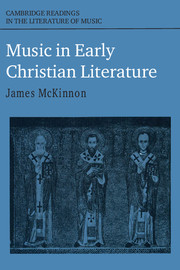Book contents
- Frontmatter
- Contents
- Preface
- Introduction
- 1 The New Testament
- 2 The Christian literature of the first and second centuries
- 3 The Greek authors of the third century
- 4 Western authors of the third and early fourth centuries: Carthage and Rome
- 5 Fourth-century Alexandria and desert monasticism
- 6 Fourth-century Asia Minor: the Cappadocians
- 7 Palestine, Antioch and Syria
- 8 The Greek historians
- 9 The Apostolic Constitutions, Egeria, and the eastern councils
- 10 Western authors of the fourth and early fifth centuries
- 11 Augustine and minor western authors
- Epilogue
- Bibliography
- Index of musical and liturgical terms and concepts
Introduction
Published online by Cambridge University Press: 05 June 2012
- Frontmatter
- Contents
- Preface
- Introduction
- 1 The New Testament
- 2 The Christian literature of the first and second centuries
- 3 The Greek authors of the third century
- 4 Western authors of the third and early fourth centuries: Carthage and Rome
- 5 Fourth-century Alexandria and desert monasticism
- 6 Fourth-century Asia Minor: the Cappadocians
- 7 Palestine, Antioch and Syria
- 8 The Greek historians
- 9 The Apostolic Constitutions, Egeria, and the eastern councils
- 10 Western authors of the fourth and early fifth centuries
- 11 Augustine and minor western authors
- Epilogue
- Bibliography
- Index of musical and liturgical terms and concepts
Summary
In working with early Christian references to music one comes gradually to distinguish four principal categories of material. The most obvious perhaps is that chorus of denunciation directed against pagan musical customs, concentrating with special fervor on musical instruments. A second, seemingly contradictory, category is made up of passages that signal acceptance of music as one of the liberal or encyclical arts. The third consists in musical images or figures of speech. And finally there is the category of most interest to music historians, passages that shed some light on early liturgical chant.
Clearly this is a practical categorization rather than one with absolute logical validity. The categories differ in kind: one of them – musical imagery – is a mode of expression while the other three have to do with particular subjects. Occasionally there is overlap among them: the same passage might for example contrast the lascivious music of a pagan banquet with sober monastic pslamody. And then one encounters from time to time a passage that falls outside the system, for instance, an unbiased historical reference to some facet of music in classical Greece. It is nonetheless true that the categorization has considerable value as a first step in sorting out an initially confusing mass of material, and that a surprisingly large majority of patristic references to music is well served by it.
- Type
- Chapter
- Information
- Music in Early Christian Literature , pp. 1 - 11Publisher: Cambridge University PressPrint publication year: 1987



